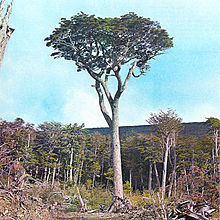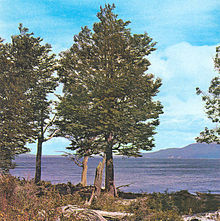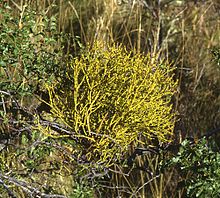Dummy booking
| Dummy booking | ||||||||||||
|---|---|---|---|---|---|---|---|---|---|---|---|---|

Pellin beech ( Nothofagus obliqua ), habitus |
||||||||||||
| Systematics | ||||||||||||
|
||||||||||||
| Scientific name of the family | ||||||||||||
| Nothofagaceae | ||||||||||||
| Kuprian. | ||||||||||||
| Scientific name of the genus | ||||||||||||
| Nothofagus | ||||||||||||
| flower |
The beeches ( Nothofagus ), very often called southern beeches , are the only genus of the beech family (Nothofagaceae) within the beech-like order (Fagales). They are native to the southern hemisphere .
description



Appearance and leaves
Most of the species are trees , and a few are shrubs . 26 species are evergreen , seven deciduous and two semi- evergreen .
The alternate and mostly spiral, sometimes two-line arranged leaves on the branch are divided into petiole and leaf blade. The leaf blades are simple. The leaf margins are seldom smooth, mostly serrated, notched or serrated. Stipules are present.
Inflorescences and flowers
The dummy beeches are single-sexed ( monoecious ). The small flowers stand individually in the leaf axils or axillary inflorescences . Up to five male flowers stand together in the inflorescences; they are enveloped by bracts. In the female inflorescences there are one to three female flowers, also covered by bracts.
Male flowers usually consist of six scale-like, overgrown bracts and six to 15 fertile stamens (sometimes more, but some authors also refer to such organs in the Nothofagus with many stamens as pseudanthia , so there are actually several flowers). In the female flowers, their bracts are in a circle and two to three carpels are fused together to form a two- or three- chamber ovary. Each ovary compartment contains two ovules. There are as many styles as carpels. Pollination takes place via the wind ( anemophilia ).
- Rauli southern beech (Nothofagus alpina) inflorescences
fruit
The fruits are small nuts . Two to seven fruits stand together and are surrounded by a fruit shell, a scaly or prickly one ( cupula ). Contrary to previous assumptions, the cupula has not proven to be homologous to that of the beech family . This means that the main argument for belonging to the beech family of the pseudo beeches does not apply, although the more distant relationship to these remains within the beech-like family.
Pollen
The pollen of the pseudo-beeches differ significantly from those of the other beech-like beeches . They are radially symmetrical, approximately oblate and isopolar and have four to ten germ openings ( apertures ). There are eight types of pollen:
- fusca a: in the subgenus Fuscospora
- fusca b: in the subgenus Nothofagus
- brassii a: in the subgenus Brassospora
- brassii b: only fossil
- brassii c: only fossil
- menziesii : in the subgenus Lophozonia
- ancestral a: only fossil
- ancestral b: only fossil
The fossil pollen is called Nothofagidites .
distribution
The genus Nothofagus and thus the family has a disjoint area : it is represented in southern South America , Australia , New Zealand , New Guinea and New Caledonia . This distribution is typical of taxa that had already developed when the great continent Gondwana still existed. After drifting apart of the land masses the areas of species are now far apart. Since the species of this genus occur exclusively in the southern hemisphere, they are most often referred to as southern beeches.
The distribution area ranges from the equator to 54 south latitude , from sea level to the sub-alpine tree line . The locations are found in tropical and temperate rainforests .
Evolutionary history
Even in the geological past, the false beeches were always limited to the southern hemisphere . The origin of the beech-like is believed to be in Southeast Asia . One branch of the beech family (including the ancestors of the beech family and the birch family ) is believed to have migrated northwards, while the other (including the ancestor of the beech family) is postulated to migrate southwards .
False beech fossils are known from southern South America , Antarctica , Australia , New Guinea and the neighboring islands, New Zealand and Tasmania , but not from Africa and India . The origin of Nothofagus was certainly in the southern high latitudes, followed by radiation to the other southern hemisphere regions during the Late Cretaceous and Tertiary . Due to the complete absence of Nothofagus in Africa and India, radiation can only have started after these continents separated from the unified Gondwana land mass.
Nothofagus pollen occurs for the first time in the early Campaniums of southern South America and the Antarctic Peninsula . This is the first ever appearance of the genus. Since the late Campanian or early Maastrichtian are pollen from all four recent subgenera of West Antarctica known and South America. From there they can reach Australia , Tasmania and New Zealand . New Guinea is only Brassospora known (since the Middle Eocene ) and only in the Pleistocene reached Brassospora the only subgenus Caledonia.
This spatial and temporal distribution pattern suggests an origin of Nothofagus in the biogeographical " Weddell Province ". The greatest diversity and maximum distribution of Nothofagus has been demonstrated for the late Oligocene and early Miocene . Since then, apart from New Guinea and New Caledonia, there has been a decline in distribution and diversity, as well as an extinction of Brassospora in all other regions. This is certainly a consequence of the climatic changes in the southern hemisphere since the Eocene- Oligocene border.

Systematics
The genus Nothofagus was previously assigned to the beech family (Fagaceae). Regardless of this assignment, they belong to the order of the beech-like (Fagales). The botanical name is derived from the Greek word nothos for false, spurious, hence the German translation of Nothofagus = false beech, because they are trees that are very similar to beeches and also have a certain relationship with them.
The genus Nothofagus was established in 1850 by the German-Dutch botanist Carl Ludwig Blume in Museum Botanicum , 1, p. 307. Synonyms for Nothofagus flower are Myrtilloides Banks & Sol. ex Hook. and Trisynsyne Baill. The Nothofagaceae family was founded in 1962 by Lyudmila Andreyeva Kupriyanova in First International Conference Palinol. Reports Soviet Palinol. , P. 21.
There are around 35 species of Nothofagus . The genus is divided into the following four subgenera Brassospora , Fuscospora , Lophozonia and Nothofagus :
- Subgenus Brassospora Philipson & MNPhilipson
- The type species is Nothofagus brassii , the pollen type brassii a. This subgenus with 19 species is only found in New Caledonia and New Guinea . All species are evergreen.
- Subgenus Fuscospora R.S. Hill & J. Read
- The type species is Nothofagus fusca , the pollen type fusca a. This subgenus includes four species in South America, Tasmania and New Zealand. The Nothofagus truncata , formerly regarded as the fifth species, is now regarded as the variety Nothofagus fusca var. Colensoi .
- Subgenus Lophozonia
- The type species is Nothofagus menziesii , the pollen type menziesii . This subgenus includes six species in South America, Australia and New Zealand.
- Subgenus Nothofagus
- The type is Nothofagus antarctica , the pollen type is fusca b. This subgenus with five species is only found in South America .
Here is the list of all species of the genus Nothofagus with subgenus affiliation:
| Scientific name |
German name |
Subgenus | homeland | leaves | |
|---|---|---|---|---|---|
| Nothofagus aequilateralis (Baum.-Bod.) Steenis | Brassospora | New Caledonia | evergreen | ||
| Nothofagus alessandrii Espinosa | Fuscospora | South America | deciduous | ||
| Nothofagus alpina (Poepp. & Endl.) Oerst. | Rauli | Lophozonia | South America | deciduous | |
| Nothofagus antarctica (G.Forst.) Oerst. | Antarctic beech | Nothofagus | South America | deciduous | |
| Nothofagus × apiculata (Colenso) Cockayne | |||||
| Nothofagus balansae (Baill.) Steenis | Brassospora | New Caledonia | evergreen | ||
| Nothofagus baumanniae (Baum.-Bod.) Steenis | Brassospora | New Caledonia | evergreen | ||
| Nothofagus betuloides (Mirb.) Oerst. | Magellanic southern beech | Nothofagus | South America | evergreen | |
| Nothofagus × blairii (Kirk) Cockayne | New Zealand | ||||
| Nothofagus brassii Steenis | Brassospora | New Guinea | evergreen | ||
| Nothofagus carrii Steenis | Brassospora | New Guinea | evergreen | ||
| Nothofagus cliffortioides (Hook.f.) Oerst. | New Zealand | ||||
| Nothofagus codonandra (Baill.) Steenis | Brassospora | New Caledonia | evergreen | ||
| Nothofagus crenata Steenis | Brassospora | New Guinea | evergreen | ||
| Nothofagus cunninghamii (Hook.) Oerst. | Tasmanian beech | Lophozonia | Australia, Tasmania | evergreen | |
| Nothofagus discoidea (Baum.-Bod.) Steenis | Brassospora | New Caledonia | evergreen | ||
| Nothofagus dombeyi (Mirb.) Oerst. | Coihue southern beech | Nothofagus | South America | evergreen | |
| Nothofagus flaviramea Steenis | Brassospora | New Guinea | evergreen | ||
| Nothofagus fusca (Hook.f.) Oerst. | Red beech | Fuscospora | New Zealand | semi-evergreen | |
| Nothofagus glauca (Phil.) Krasser | Blue-green southern beech | Lophozonia | South America | deciduous | |
| Nothofagus grandis Steenis | Brassospora | New Guinea | evergreen | ||
| Nothofagus gunnii (Hook.f.) Oerst. | Fuscospora | Tasmania | deciduous | ||
| Nothofagus × leonii Espinosa | |||||
| Nothofagus macrocarpa (A.DC.) FMVázquez & RARodr. | South America | ||||
| Nothofagus menziesii (Hook.f.) Oerst. | Silver beech beech | Lophozonia | New Zealand | evergreen | |
| Nothofagus moorei (F.Muell.) Krasser | Black head southern beech | Lophozonia | Australia | evergreen | |
| Nothofagus nitida (Phil.) Krasser | Shiny southern beech | Nothofagus | South America | evergreen | |
| Nothofagus nuda Steenis | Brassospora | New Guinea | evergreen | ||
| Nothofagus obliqua (Mirb.) Oerst. | Pellin beech | Lophozonia | South America | deciduous | |
| Nothofagus perryi Steenis | Brassospora | New Guinea | evergreen | ||
| Nothofagus pseudoresinosa steenis | Brassospora | New Guinea | evergreen | ||
| Nothofagus pullei Steenis | Brassospora | New Guinea | evergreen | ||
| Nothofagus pumilio (Poepp. & Endl.) Krasser | Lenga southern beech | Nothofagus | South America | deciduous | |
| Nothofagus resinosa steenis | Brassospora | New Guinea | evergreen | ||
| Nothofagus rubra steenis | Brassospora | New Guinea | evergreen | ||
| Nothofagus rutila Ravenna | South America | ||||
| Nothofagus solandri (Hook.f.) Oerst. | Black mountain beech | Fuscospora | New Zealand | evergreen | |
| Nothofagus × solfusca Allan | New Zealand | ||||
| Nothofagus starkborghii steenis | Brassospora | New Guinea | evergreen | ||
| Nothofagus stylosa steenis | Brassospora | New Guinea | evergreen | ||
| Nothofagus truncata (Colenso) Cockayne | New Zealand | ||||
| Nothofagus womersleyi Steenis | Brassospora | New Guinea | evergreen |
The taxa Nothofagus nervosa and Nothofagus procera mentioned earlier are now regarded as synonyms of Nothofagus alpina .
ecology
A specific symbiosis is particularly interesting: fungi of the genus Cyttaria (there are around twelve species) always live together with Nothofagus species. The genera Cyttaria and Nothofagus have the same disjoint distribution that reflects the great continent Gondwana . Both genera are found in the Australian-New Zealand area and in southern South America.
In South America, for example, the fungus species Amanita diemii , Cortinarius magellanicus , Russula fuegiana and Tricholoma fusipes live in symbiosis with various Nothofagus species. The mushroom species Amanita aurantiovelata and Russula nothofaginea only live together with Nothofagus dombeyi and Nothofagus obliqua .
Heterobathmiidae , a family of butterflies around 125 million years old and part of a group that is a sister group to all other butterflies Lepidoptera , has a very close association only with Nothofagus species. The adult animals eat the pollen and the caterpillars only Nothofagus leaves.
Pests
The leaf beetle Novocastria nothofagi (English-speaking name "Gul beetle") only attacks false beeches. The larvae go through several molting stages and then pupate in the form of white, crystal-hard spheres. The copper-colored leaf beetle hatches after two to three weeks. This species was discovered by Margaret D. Lowman in Australia in 1979 and named by Brian Selman of the University of Newcastle-upon-Tyne.
use
The three most common species planted in parks and gardens are deciduous; the evergreen species are not sufficiently hardy in Central Europe .
The wood of several types is used, some of which are of good quality.
Some parts of Nothofagus pumilio's plants are processed into food.
swell
- Description of the family of Nothofagaceae in APWebsite (Section Description and systematics)
- Diverse information on the family from the University of Graz. With an emphasis on the Tasmanian species. (German)
- Michael Heads: Panbiogeography of Nothofagus (Nothofagaceae): analysis of the main species massings. In: Journal of Biogeography , 33, 2006, pp. 1066-1075: PDF-Online.
- GJ Harden: Nothofagaceae. In: New South Wales Flora Online. National Herbarium of New South Wale, accessed April 6, 2011 .
- PB Heenan, RD Smissen: Revised circumscription of Nothofagus and recognition of the segregate genera Fuscospora, Lophozonia, and Trisyngyne (Nothofagaceae). In: Phytotaxa , Volume 146, Issue 1, 2013, pp. 1–31. doi : 10.11646 / phytotaxa.146.1.1
- R. Vergara, MA Gitzendanner, DE Soltis, PS Soltis: Population genetic structure, genetic diversity, and natural history of the South American species of Nothofagus subgenus Lophozonia (Nothofagaceae) inferred from nuclear microsatellite data. In: Ecology and Evolution , Volume 4, Issue 12, 2014, pp. 2450-2471. doi : 10.1002 / ece3.1108
- RS Hill, GJ Jordan, MK Macphail: Why we should retain Nothofagus sensu lato. In: Australian Systematic Botany , Volume 28, 2015, pp. 190–193.
Individual evidence
- ↑ First publication of the generic name scanned at biodiversitylibrary.org .
- ^ Nothofagaceae in the Germplasm Resources Information Network (GRIN), USDA , ARS , National Genetic Resources Program. National Germplasm Resources Laboratory, Beltsville, Maryland.
- ^ Nothofagaceae at Tropicos.org. Missouri Botanical Garden, St. Louis
- ↑ See entry in Kew Checklist .
- ↑ See Rafaël Govaerts (Ed.): Nothofagus. In: World Checklist of Selected Plant Families (WCSP) - The Board of Trustees of the Royal Botanic Gardens, Kew . .
- ↑ Assignment to sub-genera according to Paul S. Manos: Systematics of Nothofagus (Nothofagaceae) based on rDNA Spacer Sequences (its): Taxonomic Congruence with Morphology and Plastid Sequences. (pdf; 206 kB) In: American Journal of Botany 84 (9). 1997, pp. 1137–1155 , accessed February 26, 2011 (English).
- ↑ Entry in Plants for a Future. (engl.)
- ↑ Use of Nothofagus pumilio . (engl.)
Web links
- Entry in the florachilena with links to the Chilean species. (span.)
- The South American beech forests, brief overview. (German)
- Southern beech species as timber. (German)
- Nothofagus overview. (German)
Supplementary literature
- Illa Martin : Cultivation and cultivation of Nothofagus in Germany. (Information from the German Dendrological Society No. 70). Ulmer, Stuttgart 1979, ISBN 3-8001-8302-1 .




